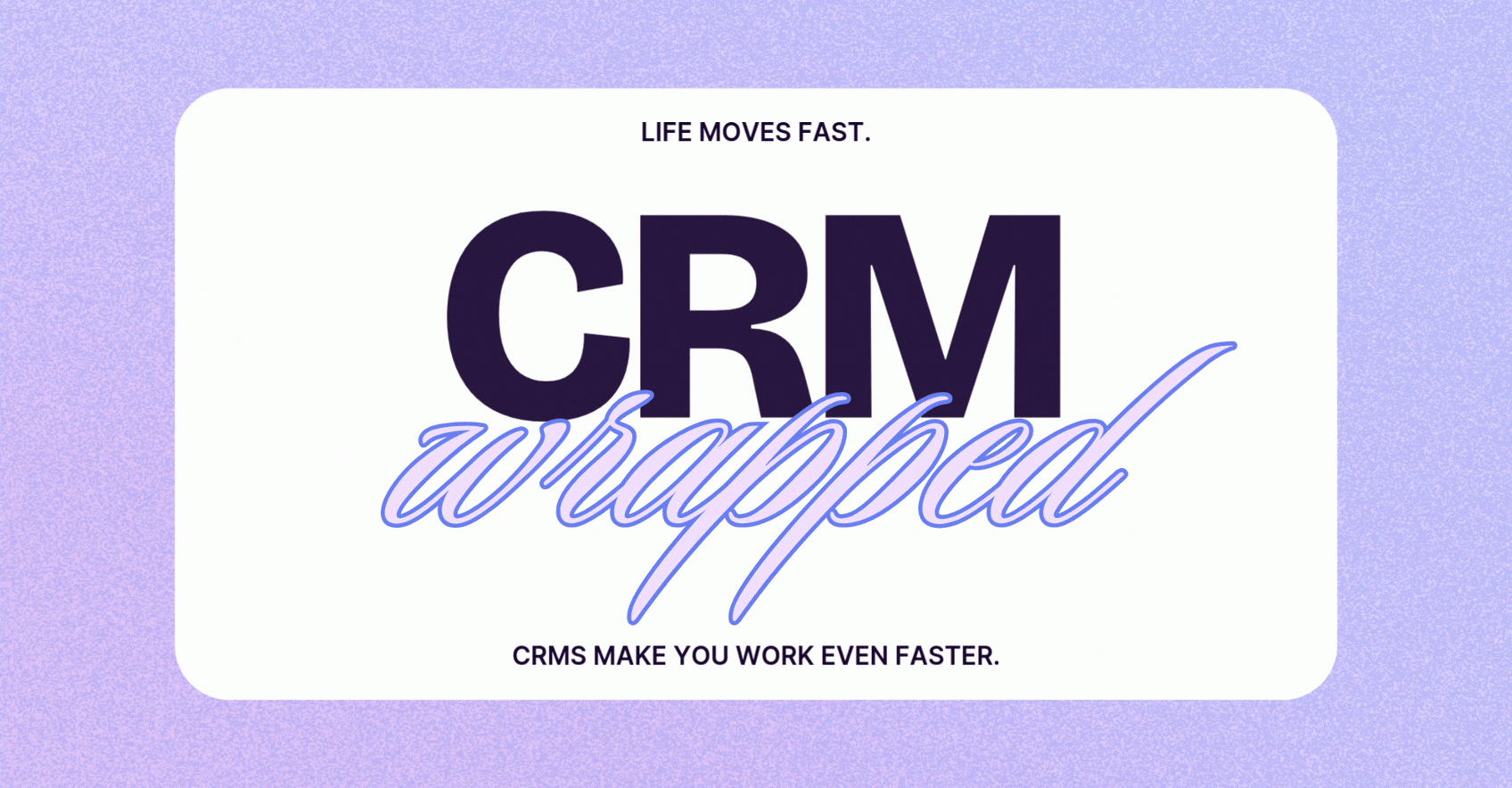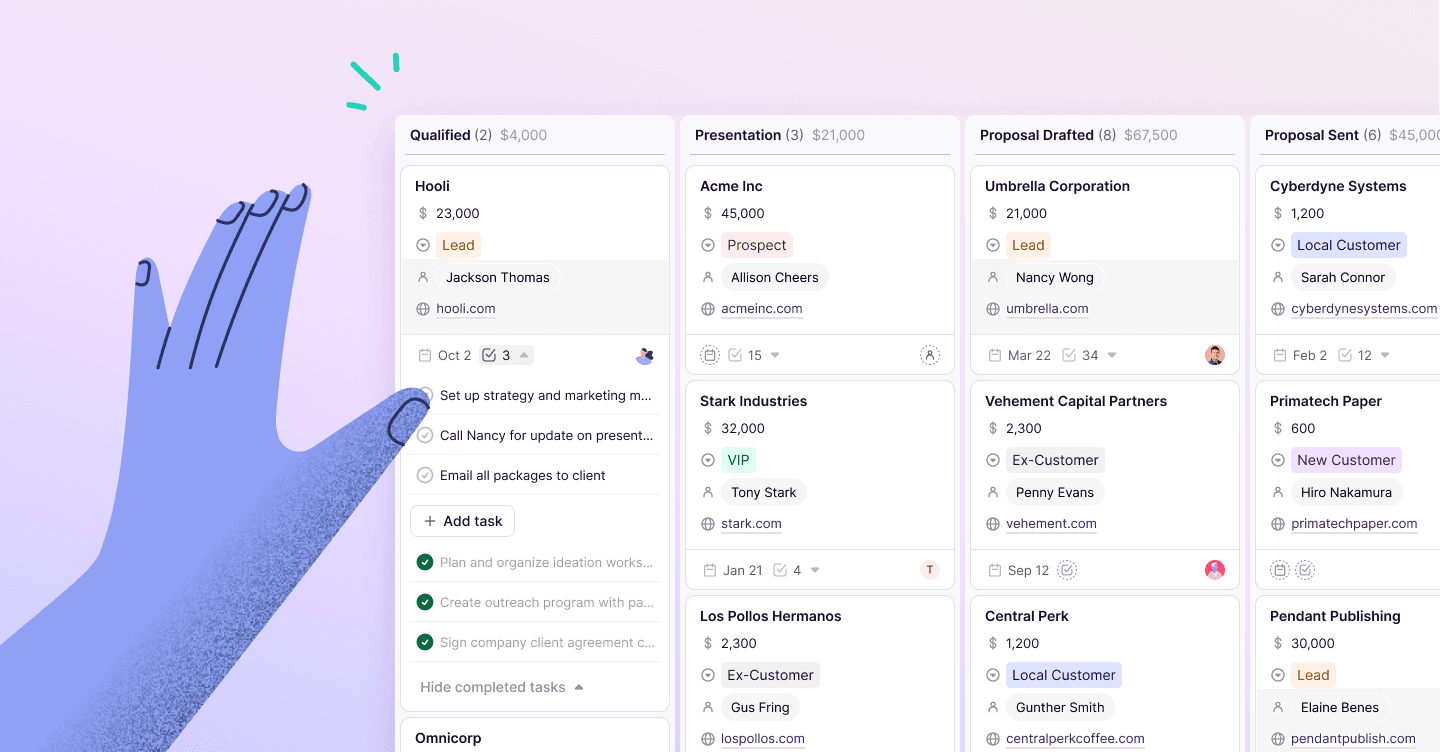Kent Holland
Vice President of Sales at Copper
Sales tools are advancing faster than ever, and emerging technologies — like advanced automation and powerful machine learning — are already redefining our daily workflow.
But the year's biggest changes are being driven by a more fundamental trend: building ongoing, long-term customer relationships are more important than they've ever been. It's time to throw out the old playbook of transactional sales and rebuild our sales strategies with customer relationships right at their heart.
1. Revenue Is Becoming a Whole-Team Pursuit, Not Just Sales
In 2018, we're shifting further and further away from the old “transactional” world of one-off sales, and toward an economy fueled by repeat purchases and enduring customer relationships.
This applies in both business and consumer worlds: The software-as-a-service market is on track to be worth $162 billion within the next two years, and there are over 5.7 million “subscription box” customers in the U.S. alone using services like Blue Apron and Ipsy.
As a result of that shift, the sales process is more complex than ever. Revenue generation is no longer the sole reserve of sales teams: marketing, customer success, and product teams all have a direct impact on a company's bottom line:
- Marketing teams create educational content to address common objections and accelerate the sales process.
- Customer success teams combat churn and generate revenue through upselling and cross-selling.
- Product teams drive word-of-mouth referrals through stellar product experiences.
With so many touchpoints between customer and company, everyone within a company has become part of the customer relationship. Sales strategies are no longer driven solely by customer acquisition; as Price Intelligently's Patrick Campbell explains, customer retention is the real engine of growth:
“As a field, we are obsessed with acquisition, because we naturally think more customers = more revenue. This line of thinking ironically won't make you grow. True growth in SaaS doesn't come from new customers, it comes from existing customers. As they grow, you grow. As you grow, they grow.”
Recommended Reading
- Subscription Businesses Are Exploding With Growth by Richard Kestenbaum for Forbes: an overview of the rapid rise of the subscription-box market and predictions for future growth.
- 30%+ of your revenue should be expansion revenue. You're likely only at 10%. by Patrick Campbell at Price Intelligently: a data-driven look at exactly how retained customers drive business growth.
2. We'll Stop Fixating on Customer Records and Start Focusing on Customer Relationships
As retention becomes more important, generating sales won't be as simple as collecting lead data, funneling it into the sales pipeline, and waiting for revenue to appear at the end; it'll be a cyclical process, requiring repeated, meaningful interactions with customers for months and years after the initial sale.
As a result, effective sales strategies will be judged less by the data they generate — lead scores, close/win rates, and deal volume — and more by the quality of experience they generate. Instead of being phone jockeys, sales reps will get to apply the skills and knowledge they've acquired through their careers:
“A great salesperson is the most knowledgeable member of your team. They know everything about your customers, everything about your product, everything about your company.” — Dimitar Stanimiroff, Heresy
That means ditching the “sales hack” mentality and abandoning tactics like:
- Calling prospects at unsociable hours to maximize the chances they'll pick up.
- Intentionally overselling products.
- Forcing customers toward a sale at your speed, not theirs.
Instead, there'll be greater focus on ongoing conversations, helpful advice, and valuable resources. Data collection will cease being a goal in its own right and will instead become an aide to personal relationships with customers.
Recommended Reading
- Taking Back Control of Sales by Dimitar Stanimiroff at Heresy: practical advice for helping salespeople shift from sales-hacking to genuine relationship building.
- Outdated Sales Tactics to Abandon in 2018 by Dan Tyre for HubSpot: real-world examples of outdated, customer-unfriendly sales hacks still used by many sales teams.
3. CRM Becomes a Tool for All Relationship Makers
Everyone in a company is a potential “relationship maker,” but historically, CRMs have been designed purely for salespeople — and salespeople alone — to manage relationships.
In 2018, we'll see the end of CRM systems as a siloed sales tool. Instead, they'll become relationship hubs, providing quick, shared access to customer information that marketing, product, and success teams can use just as readily as sales. That means:
- Consumer-grade experiences: Anyone in the company can effectively use a CRM without a ton of setup or training.
- More integrations: Relationship data needs to be available directly in the tools and processes that need it, like email, document collaboration, and reporting.
- Shared reporting: Sharing access to lead scores, conversion rates, and churn rates will make it easier to work out the marketing channels and customer success strategies that generate long-term customers.
Instead of being “just another sales tool,” CRM systems need to form the backbone of the entire customer relationship: connecting every relationship maker to every customer.
Recommended Reading
- 18 New Features to Empower Relationship Managers by Erin Sumpmann at Copper: Discover eighteen powerful relationship-enabling features that drive the Copper CRM.
4. More Conversations, Fewer Forms
Lead generation typically looks like this: Put a piece of valuable content behind a long-winded contact form, and ask for a ton of personal data in exchange.
But no matter how effective at generating leads the process is, it still boils down to holding potential customers for ransom instead of delivering as much value as you can. Fundamentally, it feels wrong. In the words of Drift's Daniel Murphy:
“Asking a potential customer a bunch of questions before you’ve provided them with answers just doesn’t feel right. So we don’t do it.”
In 2018, we'll see more companies move away from content-gating and toward a lead-generation strategy that offers more up-front value: chat bots. By replacing forms with a pop-up prompt to start a conversation, lead generation stops being a tit-for-tat trade: Customers connect with your company on their terms, entering the marketing funnel only when it suits them.
By leveraging its own software, Drift was able to ungate all of its content and still see a net gain in lead generation. Simple sales queries are handled by AI instead of wasting valuable sales time, and the complex work of building real relationships is left to skilled sales reps.
Recommended Reading
- How “No More Forms” Can Unlock Unprecedented Growth by Daniel Murphy at Drift: an in-depth case study of Drift's journey away from content-gating and toward live chat.
5. The “Sales CMS” Will Supercharge Sales Content
With a world of information at our fingertips, online resources such as blog posts, sales decks, and case studies play a crucial role in making a purchase decision. Locked up in those resources is a wealth of valuable sales information:
- If a prospect reads and rereads a blog post about customer acquisition costs, chances are he or she is spending too much on new customers.
- If another prospect downloads a case study comparing your product to your closest competitor's, that prospect would probably benefit from an immediate sales call.
But for most companies, that insight is scattered across dozens of apps and communication channels. Blog post analytics are hidden away in Google Analytics, while your case studies are stored in Google Drive. Even your communication with prospects is fragmented: Your interactions might span social media, live chat, and email.
The more content we create, the harder it becomes to understand how people actually use it, so savvy sales teams are improving how they manage their content. In practice, that means:
- Creating a “sales CMS”: organizing content by sales-specific criteria, such as sales funnel stage, customer segment, or product line.
- Tracking how prospects engage with content: seeing which emails get read and which sales decks get opened.
- Finding your best-performing resources: identifying the content that your best customers engaged with during the start of your relationship.
Instead of sending generic follow-up sequences, sales teams will start using actual customer data to develop personalized, perfectly timed emails, sharing blog posts and case studies that have a track record of helping generate new customers.
Recommended Reading
- Marketing & Sales CMS: Necessity or Nuisance? by Matt Greener for App Data Room: dozens of statistics that highlight the impact content management has on sales and marketing performance.
6. Less Manual Data Entry, Deeper Lead Insight
Lead-qualification calls are a source of frustration for prospects and reps alike. Sales reps need to fill out their spreadsheet with information about company size and job seniority; prospects just want to learn about the product. Nobody wins.
“They’re trying to qualify you. You can feel it and that’s awful. They ask those qualifying questions: “When are you wanting to buy? What’s your budget?” And I’m like, “Can I know about the product before I answer those questions? Can I have the experience first?” — Guillaume Cabane, Drift/Segment
Thankfully, technology is already paving the way for a smoother, simpler solution to the problem of lead qualification. Most of the information sales reps need during their qualification call already exists somewhere on the web, including:
- Company and company size.
- Job title and seniority.
- Contact details and social media accounts.
Data enrichment services, like Clearbit, are designed to automatically track down that information. Taking things a step further, Copper brings data enrichment directly into the CRM environment, automatically building detailed lead profiles at the click of a button.
Ultimately, that means less data entry, better lead insight, and a better customer experience. As more companies make the switch to data enrichment, prospects will become less tolerant of invasive qualification calls. Instead of being a nice-to-have, data enrichment will become an essential part of the sales process.
Recommended Reading
- 7 Lessons From Our VP of Growth That Will Make You Rethink Sales Email by Erik Devaney at Drift: a roundup of seven suggestions for building a sales process driven less by manual data entry and more by human interaction.
7. ”Video Voicemail” Will Humanize Cold Email
It's harder than ever to engage sales prospects. Crowded inboxes mean that cold emails net a dismal 1 percent response rate, while warm emails fare only marginally better, averaging a 2–3 percent click rate. A strategic approach to sales emails — sending short, focused, personalized messages — can nudge these numbers upward, but better results require a more radical change.
In 2018, that change is happening in the form of the “video voicemail.”
Thanks to tools like Wistia, it's quick and easy to record short, highly personalized video messages and embed them directly into emails. According to the company's sales manager, Meagan Thatcher, video voicemails work in even the busiest of sales environments:
“When you have 100-plus calls to make a day, it's pretty easy to make a quick video message and get it out quickly."
In a world where we're constantly barraged by text-heavy emails, video content is a real differentiator: Instead of opening an email to a templated outreach message, we're greeted by a smiling thumbnail of a real person.
Video voicemails apply a novel format to tackle the same themes a conventional sales email would:
- Introducing the sales rep.
- Explaining the motivation for reaching out.
- Offering a simple next-step, like a short phone call.
But by humanizing an impersonal part of the sales process, Wistia generated a 300 percent increase in the click rates of their cold emails. As well as boosting performance, video voicemails mean that sales emails can be more than a way to arrange your next sales call — they can plant the seed of a personal, active customer relationship.
Recommended Reading
- How to Instantly Add Value to Your Cold Emails by Gabrielle Hughes at Copper: Discover a simple framework for delivering maximum value through your cold emails.
- The 4 rules for sending cold email that converts in 2018 by Guillaume Cabane for Clearbit: Guillaume shares tips from moving from “spray and pray” email to purposeful, targeted outreach.
8. Automation Will Power Seamless “Next Steps”
Writing follow-up emails, scheduling meetings, and sending proposals all eat into your sales reps' time — time that would be better spent coming to grips with the pains and passions of potential customers.
In 2018, we'll see huge chunks of this busywork taken away from sales reps and managed by automation. From automatic personalization of emails to perfectly timed follow-ups with leads you haven't heard back from, tedious, unskilled tasks will fall to your CRM software, not your reps.
As Jordan Wan from CloserIQ explains, automation won't homogenize the customer experience — it'll free-up salespeople to spend more one-on-one time with their prospects:
“Technology should serve to augment understanding of your prospects, rather than replace it. Automating tedious processes offers many advantages, but fundamental sales skills such as effective listening and communication remain paramount even as these sales technologies accumulate.”
Recommended Reading
- 3 Automations to Add to Your New Years Resolution by Gabrielle Hughes at Copper: a short webinar offering actionable strategies for incorporating automation into your sales process.
9. Pipeline Management Becomes Predictive
Forty-four percent of sales reps think their organizations have a problem managing their sales pipelines. It's no surprise: Tracking thousands of leads, dozens of reps, and multiple pipeline stages is a mammoth organizational task, complicated by the simplistic reporting functionality offered by many CRM systems.
Further into 2018, we'll see more companies move toward predictive pipeline management: using machine learning to avoid the quarterly fire sale and proactively identify and solve potential problems in the sales pipeline.
“No company can perfectly predict how much revenue they will make in a given month. . . . There are simply too many variables to consider. But perfection is not the goal. Forecasting is about getting close enough to make good decisions.” — Matt Sornson, Clearbit
Though perfect forecasting is out of reach, we can use smart CRM systems to make pragmatic sales decisions. That means:
- Making sense of hundreds of sales-intent signals to move prospects through the funnel at the right time.
- Forecasting pipeline revenue and predicting how much is destined to close.
- Working back from pipeline reporting to actual lead data in a couple of clicks.
Pipeline management will stop being a reactive process, and sales teams will be able to translate customer data into crucial course corrections whenever they're needed.
Recommended Reading
- How to Supercharge Your Sales Pipeline with Predictive Intelligence by Amanda Kahlow for Selling Power: actionable suggestions for incorporating pipeline forecasts into your current process.
- Making Data-Driven Decisions with your Sales Management System by Gabrielle Hughes at Copper: three quick tips for using data to make informed sales decisions.
10. The Birth of the Unified Sales Stack
In recent years, the marketplace for sales tools has become more and more fragmented. Where there was once a handful of all-in-one software suites, there are now hundreds of specialist companies.
Confronted with so much choice, sales teams are increasingly developing their own one-of-a-kind tool stacks; in the words of Scott Brinker, HubSpot's VP of Platform Ecosystem, they are “bak[ing] their own, special marketing and customer experience cake.”
But while best-in-class tools provide some measure of competitive advantage, they can also cause problems. Each of these products brings with it a new interface, new processes, and new ways to store data. Very quickly, your best-in-class tools become a mess of different dashboards, APIs, and siloed information.
In 2018, we will see a process of unification. As we near the limit of how many stand-alone apps we can manage, we'll start to see sales tools building on top of existing software, augmenting existing services instead of competing with them.
That's the ethos behind Copper's decision to integrate into Google Cloud's G Suite. Instead of building out another tool to compete for your attention, best-in-class CRM functionality is built directly into the tools where you already spend most of your time: Gmail, Google Drive, and Chrome.
Recommended Reading
- The biggest problem with CRM: solutions for overcoming the biggest CRM challenge facing sales teams — effective adoption of new tools.
In 2018, Build Relationships into the Heart of Your Business
This year, great sales performance will be defined by great customer relationships. While adopting new technologies will improve your sales performance, the biggest benefits will come from redefining how you manage long-term interactions with new and existing customers alike.
Instead of relying on simplified customer data and one-off sales, it's time to focus your energy — and the energy of your whole team — on creating remarkable, long-term customer relationships.





